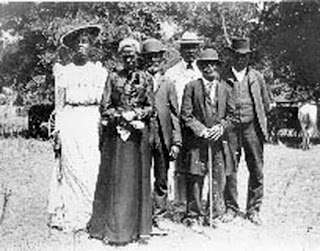GRANVILLE T. WOODS, ESQ. (April 23, 1856 – January 30, 1910), Electrician—Mechaiucal-Engineer-Manufacturer of Telephone, Telegraph and Electrical Instruments.
Some men are born great; some have greatness thrust upon them and some achieve greatness." To the last class belongs G. T. Woods, who was born in Columbus, Ohio, April 23,1856. He attended school until he was ten years of age, when he was placed in a machine shop where he learned the machinist and blacksmith trades. In the meantime he took private lessons and attended night school, and exhibited great pluck and perseverance in fitting himself for the work he desired to undertake. He pursued with assiduity every study which promoted that end. November, 1872, he left for the West, where he obtained work as a fireman and afterwards as an engineer on one of the Iron Mountain Railroads of Missouri. While in the employ of the railroad company he had a great deal of leisure, and as saloons had no attractions for him, he took up the study of electricity as a pastime.
In December, 1874, he went to Springfield, Illinois, where he was employed in a rollingmill. Early in 1876 he left for the East, where he received two years special training in electrical and mechanical engineering at college. While obtaining his special instructions, he worked six half days in each week in a machine shop, the afternoon and evening of each day being spent in school. February 6, 1878, he went to sea in the capacity of engineer on board the Ironsides, a British steamer. While a sailor, he visited nearly every country on the globe. During 1880 he handled a locomotive on the D. & S. Railroad. Since then he has spent the major portion of his time in Cincinnati, Ohio, where he has established a factory for the purpose of carrying on the business, as indicated at the head of this sketch. A company has been formed recently for the purpose of placing Mr. Woods' Electrical Railway Telegraph on the market.
In the United States patent office, in the case of- Woods vs. Phelps' RailwayTelegraph Interference—L. M. Hosea, attorney for Woods, and W. D. Baldwin, attorney for Phelps—it will be shown that the patent office has decided that Mr. Woods was the prior inventor of this system.
The following appeared in the Cincinnati Sun:
Granville T. Woods, a young colored man of this city, has invented a new system of electrical motor, for street railroads. He has invented also a number of other electrical appliances, and the syndicate controlling his inventions think they have found Edison's successor.
The Cincinnati Colored Citizen, in its issue of January 29, 1887, says:
We take great pleasure in congratulating Mr. G. T. Woods on his success in becoming so prominent that his skill and knowledge of his chosen art compare with that of any one of our best known electricians of the day.
The Catholic Tribune, January 14, 1886, said of him:
Granville T. Woods, the greatest colored inventor in the history of the race, and equal, if not superior, to any inventor in the country, is destined to revolutionize the mode of street car transit. The results of his experiments are no longer a question of doubt. He has excelled in every possible way in all his inventions. He is master of the situation, and his name will be handed down to coming generations as one of the greatest inventors of his time. He has not only elevated himself to the highest position among inventors, but he has shown beyond doubt the possibility of a colored man inventing as well as one of any other race.
The following appeared in the American Catholic Tribune, April 1, 1887 (Cincinnati, Ohio):
Mr. Woods, who is the greatest electrician in the world, still continues to add to his long list of electrical inventions.
The latest device he invented is the Synchronous Multiplex Railway Telegraph. By means of this system, the railway despatcher can note the position of any train on the route at a glance. The system also provides means for telegraphing to and from the train while in motion. The same lines may also be used for local message without interference with the regular train signals.
This system may be used for other purposes. In fact, two hundred operators may use a single wire at the same time. Although the messages may be passing in opposite directions, they will not conflict with each other.
In using the devices there is no possibility of collisions between trains, as each train can always be informed of the position of the other while in motion. Mr. Woods has all the patent office drawings for these devices, as your correspondent witnessed.
TEXT and IMAGE CREDIT: Men of mark: eminent, progressive and rising
































